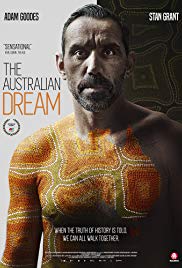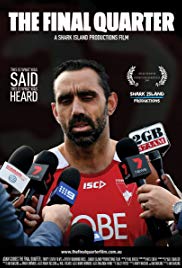THE AUSTRALIAN DREAM,
A NECESSARY AND COMPELLING EXAMINATION OF CONSCIENCE
This post is immediately relevant for Australian visitors to this site.
We hope that it will of interest and concern to visitors from beyond Australia

Racism often surfaces in Australian life. Two films about the experience of professional indigenous AFL footballer and Australian of the Year, 2014, Adam Goodes, was subject of a toxic combination of racial hooligan animosity with cutting down of tall poppies.
The two current documentaries should be necessary viewing for us all: The Final Quarter which aired on Channel 10 and The Australian Dream which is in current cinema release.
Film reviews from the Australian Catholic Office for Film and Broadcasting.
Australia, 2019. Featuring Adam Goodes, Stan Grant, Nova Peris, Gilbert McAdam, Michael O'Loughlin, Paul Roos, John Longmire, Tracey Holmes, Linda Burney, Nicky Winmar, Nathan Buckley, Natalie Goodes, Brett Goodes. Directed by Daniel Gordon. 105 minutes, Rated M (Racism and strong coarse language).
The Australian aborigines have the Dreaming. For those who came later to the land, there is always the reshaping and re-hoping of The Australian Dream.
Adam Goodes, AFL star, Brownlow medallist winner, Australian of the year 2014, is the subject of two 2019 documentaries, The Final Quarter, shown on television, and this film which has a commercial release.
It is a film which is significant for all audiences in Australia.
Initially, a collage of images and episodes indicates the controversial nature of the film and opinion divisions in Australian society about Adam Goodes, his aboriginality, his response to racist responses and insults leading to continued booing during his play, especially in 2014 and 2015, and the criticisms of his being named Australian of the Year.
For those who admired Goodes as a talented player and for those who do not know much about him, the first part of the film is an excellent tribute to his talent and skills, telling excerpts from a variety of games. It is in this context that we see him as Australian of the Year, hearing his speeches, focusing on his background as an aboriginal Australian, Australian aboriginal, and the challenge to long attitudes of racism, the challenge to fairness and justice.
Goodes agreed to be interviewed for this film which gives him an opportunity to reflect on his upbringing, lack of knowledge about being aboriginal, his gradual learning, doing courses, becoming more articulate on the issues, the affirmation that he received in the first decade and more of his football career, it also ships, the shock and disappointment of the insults, the wear and tear of the continued booing harassment, the psychological consequences, the growing disenchantment with AFL.
The narrative of the film was written by Stan Grant who also appears significantly offering comment on Goodes himself and his experience with excerpts from significant speeches that he gave on these issues, speaking from the inside and his own experiences as a national and international journalist.
There are also many interviews, the strong presence of Adam Goodes’ mother, his marriage to Natalie and her support, a variety of football personalities, inside racial and political views by Nova Peris and Linda Burney, strong comment by sports television personality, Tracey Holmes.
All strong dramas have a significant villain – and, in this film’s case, media commentator, Andrew Bolt, with excerpts from his television programs, serves as a devil’s advocate concerning (with critical attack) Goodes. And, there are glimpses of an unwise fool in television personality Sam Newman. Eddie McGuire comes out on the side of the angels, but not without some thoughtless comments, but with some apologies.
The film, and Stan Grant, have created a challenging atmosphere for the Australian viewer, an experience of being alerted to and then being appalled at so much inherent racism, the faces and shouts of abusers, the gross inarticulate bombast of so many tweets that are shown on screen, and video of a sting racist rant.
So, the two films serve as a means for an Australian examination of conscience – and can lead to a profound challenge to Australian consciousness.

THE FINAL QUARTER
Australia, 2019, 75 minutes, Colour. Adam Goodes. Directed by Ian Darling.
In 2019, two films were made about AFL player, Adam Goodes. The Final Quarter was shown at the Sydney Film Festival and on channel 10. The other film, The Australian Dream, was screened at the Melbourne Film Festival and then had a commercial release.
For Australian audiences, both films serve as something of an examination of conscience. Adam Goodes was one of many AFL players with indigenous backgrounds – the time of the making of these films, 71 professional indigenous AFL players.
For overseas audiences, the offence depicted in these films might come to a something of a shock, the continued billing of Adam Goodes during matches, as well as racist verbal attacks, controversies in the media, the psychological pressure on goods and his finally retiring from the game. And, at the centre of the controversies, he was named as Australian of the Year, 2014.
This film has many sequences, dates and opponents, of various games from 2014 to 2016. There is plenty of opportunity to see goods and his talent on the field. He is also particularly articulate, in his making speeches, in making message videos. He acquitted himself with dignity as Australian of the Year.
While there were many commentators who are supportive of goods, and he received strong support from his mother who designed jerseys for the indigenous matches, there are quite a number of prominent names, considered Conservative (Andrew Bolt, Miranda Devine, Alan Jones) and it particularly of noxious television commentator, former player, Sam Newman, whose TV rents and accusations are featured in this film.
These years raised questions of how racist Australians were, attitudes towards indigenous people (for many a tolerance when they knew their place), outbursts, the episode of the young girl who called out a monkey epithet to Goodes and he challenged her and she was removed from the grounds, with the conservative commentators criticising him for this – while the film reminds audiences that he spoke very strongly to ask for help for the girl, that was not her fault, that this was the atmosphere in which she had grown up. There were further attacks and, prominent television broadcaster, Eddie McGuire, made a rash joke about Adam Goodes and King Kong, apologising but finding it hard to live down.
Goodes emerges from this film as a man with dignity, put upon, personally vilified at a time when other indigenous players were not. It is difficult in retrospect to understand why he was so targeted and how this targeting was contagious, month after month, for some years.
A lot of discussion, a lot of commentators, material presented for the assessment of the audience – and the challenge to the AFL and the apologies from leaders that they should have stepped in earlier to prevent the targeting of the building, but which contributes to a continued examination of conscience by all Australians.
